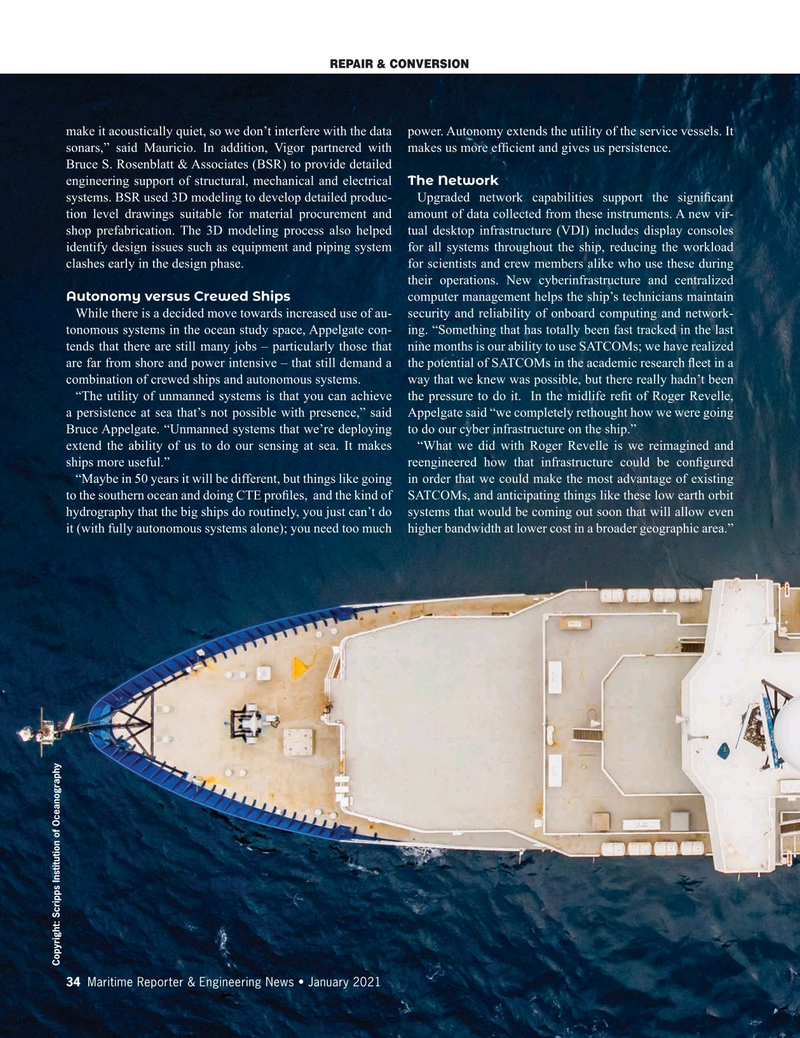
Page 34: of Maritime Reporter Magazine (January 2021)
The Ship Repair & Conversion Edition
Read this page in Pdf, Flash or Html5 edition of January 2021 Maritime Reporter Magazine
REPAIR & CONVERSION make it acoustically quiet, so we don’t interfere with the data power. Autonomy extends the utility of the service vessels. It sonars,” said Mauricio. In addition, Vigor partnered with makes us more ef? cient and gives us persistence.
Bruce S. Rosenblatt & Associates (BSR) to provide detailed engineering support of structural, mechanical and electrical The Network systems. BSR used 3D modeling to develop detailed produc- Upgraded network capabilities support the signi? cant tion level drawings suitable for material procurement and amount of data collected from these instruments. A new vir- shop prefabrication. The 3D modeling process also helped tual desktop infrastructure (VDI) includes display consoles identify design issues such as equipment and piping system for all systems throughout the ship, reducing the workload clashes early in the design phase. for scientists and crew members alike who use these during their operations. New cyberinfrastructure and centralized
Autonomy versus Crewed Ships computer management helps the ship’s technicians maintain
While there is a decided move towards increased use of au- security and reliability of onboard computing and network- tonomous systems in the ocean study space, Appelgate con- ing. “Something that has totally been fast tracked in the last tends that there are still many jobs – particularly those that nine months is our ability to use SATCOMs; we have realized are far from shore and power intensive – that still demand a the potential of SATCOMs in the academic research ? eet in a combination of crewed ships and autonomous systems. way that we knew was possible, but there really hadn’t been “The utility of unmanned systems is that you can achieve the pressure to do it. In the midlife re? t of Roger Revelle, a persistence at sea that’s not possible with presence,” said Appelgate said “we completely rethought how we were going
Bruce Appelgate. “Unmanned systems that we’re deploying to do our cyber infrastructure on the ship.” extend the ability of us to do our sensing at sea. It makes “What we did with Roger Revelle is we reimagined and ships more useful.” reengineered how that infrastructure could be con? gured “Maybe in 50 years it will be different, but things like going in order that we could make the most advantage of existing to the southern ocean and doing CTE pro? les, and the kind of SATCOMs, and anticipating things like these low earth orbit hydrography that the big ships do routinely, you just can’t do systems that would be coming out soon that will allow even it (with fully autonomous systems alone); you need too much higher bandwidth at lower cost in a broader geographic area.”
Copyright: Scripps Institution of Oceanography 34 Maritime Reporter & Engineering News • January 2021
MR #1 (34-49).indd 34 1/7/2021 5:05:43 PM

 33
33

 35
35
